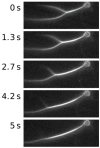Single Actin Bundle Rheology
- PMID: 29064446
- PMCID: PMC5860748
- DOI: 10.3390/molecules22101804
Single Actin Bundle Rheology
Abstract
Bundled actin structures play an essential role in the mechanical response of the actin cytoskeleton in eukaryotic cells. Although responsible for crucial cellular processes, they are rarely investigated in comparison to single filaments and isotropic networks. Presenting a highly anisotropic structure, the determination of the mechanical properties of individual bundles was previously achieved through passive approaches observing bending deformations induced by thermal fluctuations. We present a new method to determine the bending stiffness of individual bundles, by measuring the decay of an actively induced oscillation. This approach allows us to systematically test anisotropic, bundled structures. Our experiments revealed that thin, depletion force-induced bundles behave as semiflexible polymers and obey the theoretical predictions determined by the wormlike chain model. Thickening an individual bundle by merging it with other bundles enabled us to study effects that are solely based on the number of involved filaments. These thicker bundles showed a frequency-dependent bending stiffness, a behavior that is inconsistent with the predictions of the wormlike chain model. We attribute this effect to internal processes and give a possible explanation with regard to the wormlike bundle theory.
Keywords: actin; biopolymers; bundles; dynamics; mechanical properties; optical tweezers; rheology.
Conflict of interest statement
The authors declare no conflict of interest.
Figures






References
-
- Smith D., Gentry B., Stuhrmann B., Huber F., Strehle D., Brunner C., Koch D., Steinbeck M., Betz T., Käs J. The cytoskeleton: An active polymer-based scaffold. Biophys. Rev. Lett. 2009 doi: 10.1142/S1793048009000983. - DOI
-
- Lodish H.F. Molecular Cell Biology. 6th ed. W.H. Freeman; New York, NY, USA: 2008.
MeSH terms
Substances
Grants and funding
LinkOut - more resources
Full Text Sources
Other Literature Sources

